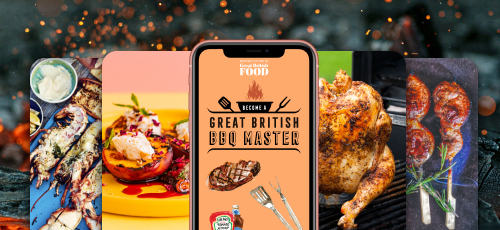Writers have rhapsodised about steak dinners for centuries.
“A mighty porterhouse steak an inch and a half thick, hot and sputtering from the griddle; dusted with fragrant pepper; enriched with little melting bits of butter of the most impeachable freshness and genuineness; the precious juices of the meat trickling out and joining the gravy,” Mark Twain is quoted as saying.
But what exactly is a porterhouse steak? And what techniques would you use to master the art of a perfect steak dinner?
These questions - and more - are answered in our guide to selecting and cooking the perfect steak.
How to select the perfect steak
“There are many different types of steak, and selecting your favourite piece of meat is down to personal preference; whether you like lots of marbling, what texture you prefer, and of course your price point,” explains Sushila Moles, founder of the New Meat Project.“Something that is really important is to select high quality steak from grass-fed, well-aged beef. That really intensifies the flavour. Many cattle are just fed animal concentrate, or hay, and kept indoors, which gives them a monotonous diet. But when an animal is outside, it's eating lots of different grasses and shrubs throughout the year; flavours and textures which really affect the taste of the meat.
“What's more, grass-fed animals are able to move around; their muscles are working, they're growing more slowly, and this also improves the flavour and texture of the meat,” she adds.
Your local butcher will be able to tell you about the provenance of the meat they sell. Butchers can also cut steaks to size for you. Many supermarkets sell very thin cuts of meat, while professional chefs prefer working with steaks that are one to two inches thick.
Alongside provenance, it's also important to consider the amount of marbling in a steak. The more marbling in a steak, the better the taste; the fat melts when cooking and enhances the flavour of the beef. However, there are those who prefer leaner cuts. Selecting a steak cut with a bone in (such as a T-Bone) is another way of adding flavour.
It's also worth noting that steaks will have a different appearance (and flavour) depending on whether they are fresh or dry-aged. Fresh meat will be bright red all the way through, and will be very soft and springy to the touch as it's full of moisture.
During the dry-aging process, moisture is drawn out of the meat, which breaks down the collagen in the muscle and allows the meat to become more flavourful and tender. The meat shrinks and darkens as it ages, becoming slowly more concave.
One of the most requested ages for a steak is around 30 days. After this point the smell of the meat intensifies and a protective white crust develops around it (similar to the rind on a cheese), which is shaved off before it's sold.

What is the best cut of steak?
Choosing the best cut of steak is partially dependent on preference, although some cuts of beef are more popular than others.
“Fillet steak is the leanest and most prized,” explains Sushila. “However, when I choose a steak I would go for a rib eye. That's from a Rib of beef, taken off the bone. It has an eye of fat that melts into the steak, making it really tender. We've been taught to think of fat as a bad thing. But marbling gives it flavour.” Rib eye, as the name suggests, is taken from the rib of the cow, and is juicy, soft and tender meat. It's also a large cut, bigger than anything cut from the tenderloin.
Tenderloin steak is another popular cut. It comes from the short loin of the cow, an area with little connective tissue, resulting in a very tender cut of beef. The filet mignon is steak cut from the end of the tenderloin, and is viewed as the very best part of the meat.
The strip steak, meanwhile, is cut from the top loin of the cow. It's tender, lean and boneless, with a good amount of marbling.
The T-bone steak is cut from the forward section of the short loin, and contains both a section of strip steak and also the tenderloin (where the sirloin steak is cut from). It's a popular cut because it incorporates both the flavour of the strip steak and the softness of the tenderloin. It's worth pointing out that this makes it a pretty expensive piece of beef.
The porterhouse steak is similar to the t-bone in many ways; the only difference is that it is cut a little thicker and incorporates more of the tenderloin. It's delicious served medium-rare with chimichurri.
Different Steak Cuts Explained: Chateaubriand, Onglet, Wagyu, Tomahawk
Alongside the popular cuts described above, there are plenty of other, lesser-known types of steak that you can buy. Sometimes the terminology feels overwhelming, but these simple definitions of unusual steak cuts should help:
CHATEAUBRIAND: Originally a 19th century dish consisting of thick fillet steak stuffed with bone marrow, these days chateaubriand refers to a steak cut from the thickest part of the tenderloin. Despite being naturally tender it is lacking in fat, meaning that it is not as flavourful as other cuts. For this reason, it is often accompanied with a rich sauce to enhance the meal.
TOMAHAWK: A tomahawk steak is cut from the rib of beef; it’s essentially a very thick ribeye steak with the bone left in. This means it has phenomenal texture and flavour, as well as an eye-catching presentation on the plate. You might struggle to find it in the supermarket, but there are plenty of online butchers where you can purchase a tomahawk steak.
PICANHA: Although you might not have heard of picanha, it’s a very popular steak cut in Brazil. Picanha steak is cut from the rump; it has a triangular shape and a thin crust of fat on top, which adds flavour. The perfect picanha steak is barbecued until medium rare and then sliced into small pieces for friends and family to share.
WAGYU: In recent years, ‘wagyu’ has become a bit of a buzzword. It’s a type of beef that originated in Japan (the literal translation is ‘wa’, which means Japanese, and ‘gyu’, which means cow). Of course, this doesn’t mean that all Japanese cattle breeds are defined as wagyu; Japanese Black, Japanese Brown, Japanese Polled and Japanese Shorthorn cattle have all been specially bred and selected, resulting in a tender, very well-marbled beef. Wagyu beef is graded according to fat colour, marbling percentage, and shape and size of ribeye area - Wagyu A5 is the highest grade that it can achieve in Japan.
The price of wagyu beef went sky-high after Japan stopped exporting beef cattle in 1997, meaning other countries only had very small numbers of Japanese cattle (221 animals made it to the USA, for example). These days there are an increasing number of wagyu beef herds in the UK, including on the Worstead Estate in North Norfolk.
ONGLET: This is the French word for hanger steak, which some believe to be a highly underrated cut of beef. It’s cut flat from the diaphragm or lower belly, has a loose texture, and often there’s a tendon running through it. It’s renowned for its beefy flavour and tenderness (as it’s cut from a muscle that does very little work). Another name for the onglet is ‘the butcher’s steak’, so-called because butchers knew its value and decided to keep it for themselves.
_500_500_c1.jpg)
How to Cook the Perfect Steak
Cooking the perfect steak is about far more than throwing it in the pan, turning it once and hoping for the best. It’s an art, or rather a science.
The first step along the road is to decide exactly how you like your steak cooked. While some love their steak flash-fried and practically raw in the middle (known as a ‘blue’ steak), others prefer a well done steak.
If you’re unsure, we’d recommend opting for medium rare; a steak that’s pink and juicy in the centre and perfectly browned on the outside.
Cooking times for steaks
Steak cooking times will vary according to the size and thickness of the steak, and whether you decide to grill or pan fry. However, you can also check that your steak has been cooked to perfection by using a meat thermometer to check that the inside has reached the desired temperature.
Average Cooking Times and Temperatures
Steak Thickness |
Rare (57°C) |
Medium Rare (63°C) |
Medium (71°C) |
Well Done (75°C) |
2 cm |
1 ½ minutes per side |
2 minutes per side |
2 ½ minutes per side |
4 minutes per side |
3.5 cm |
2 ½ minutes per side |
3 ½ minutes per side |
4 minutes per side |
5 minutes per side |
5 cm |
4 minutes per side |
4 ½ minutes per side |
5 minutes per side |
6 ½ minutes per side |
While cooking times might vary according to your cooking method — pan or grill being the most common — and the size of your steak, using a meat thermometer to gauge the internal temperature of the steak is a fairly fail-safe method.
Skilled chefs are also able to tell whether their steak is cooked due to its appearance and also it’s texture.
“When you press into the steak it should bounce back like a new mattress, not like a pillow,” Sushila explains.
In other words, there should be a springiness to a cooked steak that differs to raw meat. The more cooked a steak is, the more firm it will become. BBC Good Food has prepared an infographic to show exactly what steak ‘doneness’ should feel like by comparing it to points on your own hand.
Cooking the perfect steak: techniques to avoid toughness
There are several surprisingly easy techniques that you can use to elevate your steak.“Work from a hot pan (ideally a griddle or a cast iron frying pan),” explains Sushila of The New Meat Project. “Flavour with a sprinkling of sea salt on either side. But don’t put pepper on, it will burn! Ideally use animal fat to cook it. If you have a fatty steak you can render off from the side. If not, lard works well.”
When you cook a steak, you’re aiming for the Maillard reaction, also known as “the browning reaction”. The reaction creates brown pigment in cooked meat by rearranging amino acids and simple sugars into clusters.
So why is this important?
Because it releases a host of delicious flavours and the aromas commonly associated with baking, frying and grilling. High-speed temperature cooking speeds up the reaction, which is why it’s best to cook steak on a hot pan or grill.
Salting the steak before cooking is also a highly-effective technique. Not only does it intensify the flavour, but it also dries out the surface of the meat, making it easier to bring about the Maillard reaction. Another flavour-enhancing suggestion is to run a cut clove of garlic along the surface of the meat before cooking.
You may have heard that it’s important to set your steak aside at room temperature for at least an hour before cooking. The idea behind this is that your steak will be quicker at reaching the correct temperature in the pan.
However, some chefs dispute this notion. When J. Kenji López, Chief Culinary Advisor of Serious Eats, tried out the room temperature test, he noticed little difference between steaks left at room temperature and those cooked from chilled. A steak left out for two hours had only increased in temperature by 3°C, meaning there was very little difference.
Instead, it is recommended that you get your steak as dry as possible before cooking, either by salting it or by blotting any excess moisture with paper towels.
Pan-fried or grilled steak?
 It's much more common in England to pan-fry than it is to grill steak (perhaps due to the country's miserable weather), however, both methods of cooking have their advantages.
It's much more common in England to pan-fry than it is to grill steak (perhaps due to the country's miserable weather), however, both methods of cooking have their advantages.Thick, fat-marbled cuts of meat, such as porterhouse and rib eye steaks, work best on the grill. Go for meat that is at least an inch thick, to ensure it remains tender in the centre.
Grilled meat retains more of its nutritional value and requires less fat for cooking, making it a slightly healthier option. The meat will also absorb the flavour of whatever charcoal or wood you use for cooking, giving it a smoky flavour reminiscent of summer barbecues.
The drawback is the length of time it takes to light and prepare the grill for cooking. Your charcoal needs to be red hot and evenly distributed (which should take 20 or 30 minutes) you might prefer a quicker cooking method instead. Leaner cuts of meat will taste better pan fried, with the addition of extra fat and flavours.
If you're going to grill your steak , begin by lightly oiling the grill with vegetable oil or rapeseed oil. Rub your steak with salt and any other seasoning and place it on the grill. Every cook has different techniques for how to grill steaks.
One recommendation is to place the steak in a vertical position on the grill, then after a minute turn it 45 degrees. Repeat the same process on the other side, placing the steak ‘straight' on the grill and turning it 45 degrees. That's how you will achieve those characteristic diagonal grill marks on the surface of your meat.
Each grill is different, so the best way to tell if your steak is cooked to the desired temperature is to use a meat thermometer.
Another option is to pan-fry your steak. It's important to use a thick, heavy-duty pan or skillet. These types of pan are able to reach and retain high temperatures, which is ideal for charring your steak and getting a smoky finish. Pan-frying steak allows you greater control than using a griddle, and also enables you to get more creative with added flavouring.
As with grilled steak, we recommend salting the steak beforehand to enhance flavour. Make sure the pan reaches a high heat before drizzling a small amount of oil into the pan.
Now you can place the steak into the pan. Your first objective is to sear the steak and get that nice dark crust. Do so by frying it for a minute on either side, and making sure the edges are sealed. After that, continue to keep flipping the steak every minute while you cook it, as this helps it build up an even crust.
Once the steak is seared, you can add extra flavourings while you cook. A knob of butter, a couple of cloves of crushed garlic and sprigs of rosemary will subtly enhance the flavour.
Whether you're grilling or frying your steak, it's important to rest it for at least five minutes before cooking. When you cook steak, the juices flow into the centre of the steak, where it's cooler. But as the steak cools, the juices will migrate back from the centre and will redistribute throughout the meat, leaving the meat tender all the way through.

How to serve steak
Since you've gone to so much trouble to cook your steak perfectly, we recommend simple but complementary accompaniments. Thick cut chips are a perfect pairing, with a crispy outside and soft interior that is great for soaking up those delicious meat juices. For the same reason, duck fat potatoes are also highly recommended.
If you're grilling your steak, you could put some vegetables on the barbecue alongside it. A grilled, buttered corn on the cob really hits the spot. A simple side of seasonal steamed vegetables is another excellent choice.
And finally, we come to the sauce. It's important not to choose something that will completely overpower the taste of the steak. Peppercorn sauce is a popular pick, as is a mushroom and cream sauce.
The best online butchers to buy steak
The New Meat Project sells grass-fed beef steaks in a variety of cuts, including rib-eye, rib on the bone, rump steak and T-bone steak.
It is now easier than ever to buy the choicest cuts of meat online and get them delivered to your door. There are plenty of amazing online butchers out there:
Meanwhile, if you’d like to try wagyu beef then we recommend Worstead Estate, which sources meat from its own cattle herd, which graze on the lush pastures of North Norfolk.
Farmison & Co have won ‘Best Online Butcher’ for two years in a row, and are committed to providing better meat from small farms and outdoor-reared animals. They offer up an amazing choice of different steaks, including rarer cuts such as hanger steak and chateaubriand, the latter winning a Great Taste Award.
-
Blog
• one month ago -
Blog
• 2 months ago -
Blog
• 2 months ago -
Blog
• 4 months ago
-
Review: Stark, East Mersea
one month ago







_124_80_s_c1.jpg)




